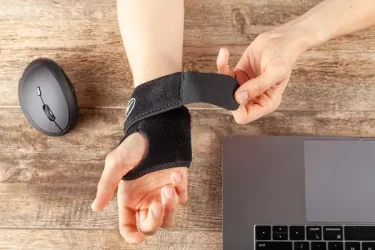Carpal tunnel syndrome is caused by pressure on the median nerve and can be a persistent challenge for many. It can cause discomfort, making everyday activities difficult. Depending on what stage of carpal tunnel you’re experiencing, you may be considering surgery.
With that in mind, we’ve selected some of the best carpal tunnel exercises to practise before surgery. This aim is to help minimise discomfort while you wait and improve your chance of a full recovery.

Private carpal tunnel surgery at a glance:
- Surgery in just 4-6 weeks
- Costs £2,049
- Available at a range of our UK locations
Call us on: 0330 828 1172
Home exercises for carpal tunnel surgery preparation
While waiting for carpal tunnel surgery, incorporating these targeted carpal tunnel relief exercises into your daily routine can help alleviate symptoms and reduce pain.
Please note, before commencing any new exercise regime, you should consult your GP, healthcare provider, or physiotherapist to ensure it’s safe to do so.
Carpal tunnel finger exercises
We’ve put together a selection of finger exercises designed to prevent carpal tunnel from worsening.
Tendon glides
Why it’s helpful: A gentle stretch that targets the tendons in the carpal tunnel
How to do it: Bend the elbow so the forearm points up and straighten the fingers and thumb so they are pointing straight up in line with the wrist. Bend the fingers, first into a hook shape, then into a fist with the thumb on top, holding each position for 3 seconds. This exercise can be done on both hands at the same time or by alternating between the hands.
Finger and thumb stretch
Why it’s helpful: Stretching the fingers and thumb helps improve circulation and relieve carpal tunnel pain.
How to do it: Stretch your fingers wide before relaxing them. Repeat this up to four times. Then grip your thumb with the opposite hand and push it backward until you feel a slight stretch. Repeat this up to four times as well.
Hand exercises for carpal tunnel
Below is a selection of exercises designed to strengthen your hands.
Hand squeeze
Why it’s helpful: Hand squeezing helps work the forearm muscles around the carpal tunnel.
How to do it: A soft rubber ball or a pair of rolled-up socks is needed for this exercise. Holding the ball in one hand, squeeze for 5 seconds, then release. Repeat this 10 times. After 3 sets of repetitions, switch to the other hand and repeat.
Hand flexor stretch
Why it’s helpful: This exercise targets the muscles in the hand, promoting flexibility and reducing tension.
How to do it: Extend your fingers, hold your hand and gently press on the back of the hand until you feel a stretch.
Wrist exercises for carpal tunnel
Wrist flexor stretch
Why it’s helpful: It stretches the muscles in your forearm and improves flexibility, mobility, and range of motion.
How to do it: Do a wrist flexion by extending your arm in front of you, pointing your fingers to the ceiling or floor and gently bending your wrist towards your body to apply extra pressure and deepen the stretch. Repeat five times, holding the position for 15 seconds each time then repeat on the other arm.
Arm exercises for carpal tunnel
Nerve glide
Why it’s helpful: Nerve gliding exercises help mobilise the median nerve, reducing compression in the carpal tunnel.
How to do it: Make a fist with one hand with the thumb on the outside. Uncurl and stretch the fingers while keeping the thumb pressed to the side of the hand. With the fingers stretched, bend the hand back towards the forearm and extend the thumb out to the side.
Using the opposite hand gently apply pressure on the thumb to stretch it. Hold each position for 3-7 seconds then repeat with the other hand.
Forearm pronation and supination
Why it’s helpful: This exercise improves forearm rotation, reducing strain on the hand and wrist.
How to do it: Hold a small weight or a can and rotate your forearm from palm face up to palm face down.
Carpal tunnel exercises to try before bed
Consider these simple exercises before bedtime to help relax your muscles, reduce pain, and improve your sleep quality:
- Finger stretching: Gently stretch your fingers by spreading them apart and holding for 15-30 seconds
- Circular wrist stretches: Rotate your wrists in circular motions to enhance flexibility
- Prayer stretch: Put your hands flat together under your chin and push them down to your waist until you feel a stretch
- Shake it out: Simply shake your hands to loosen the muscles, this can be especially useful at night when symptoms of carpal tunnel are often worse.
Our top 3 best exercises for carpal tunnel syndrome
These top three exercises have been selected to provide a strong foundation for your carpal tunnel exercise routine. Between them, they provide a well-rounded approach that addresses the different muscle groups and can be repeated several times per day.
- Hand squeeze: Squeezing a ball or rolled-up socks
- Wrist flexor stretch: Extending your arm and pulling the hand back
- Forearm pronation and supination: Holding a small weight and rotating the wrist up and down.
Preparing for your carpal tunnel surgery
Following the steps below can help you to prepare in the weeks leading up to your surgery:
- Stop smoking: smoking can slow your recovery from carpal tunnel surgery. Your operation represents a great time to quit an expensive and damaging habit
- Medication: tell your doctor about any medication you’re taking. You may need to stop taking it or be given a substitute in the event the pre-existing medication poses an increased risk during surgery
- Fasting: surgery is almost always performed under local anaesthetic. This means there’s usually no need to fast. Patients can eat, drink, and take their normal medication on the day of surgery. Please note, you should check with your pre-op assessment team to confirm.
For more information, check out our dedicated blog on preparing for surgery.
Carpal tunnel and exercise FAQs
Not quite found what you’re looking for? Our dedicated carpal tunnel exercise FAQs might be able to help!
A balanced approach is key. Both rest and exercise play crucial roles in managing carpal tunnel syndrome. Rest helps reduce swelling, while exercise maintains flexibility and strength.
Avoid exercises that involve repetitive or forceful gripping and activities that cause wrist hyperextension. These can exacerbate carpal tunnel symptoms.
In mild to moderate cases of carpal tunnel syndrome, symptoms can be alleviated with targeted exercises. However, proper medical treatment will often still be needed and severe cases may require surgical intervention.
Talk to our team to find out more about the procedure and how to get started.







